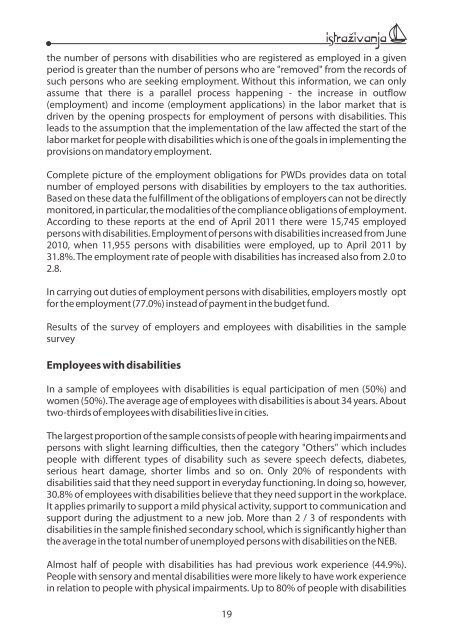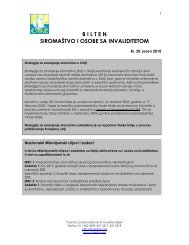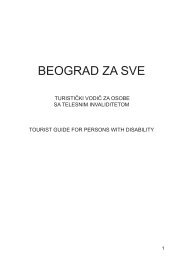OBAVEZA ZAPOŠLJAVANJA OSOBA SA INVALIDITETOM U SRBIJI Primeri dobre prakse
Preuzmite ovde - Centar za samostalni Život osoba sa invaliditetom ...
Preuzmite ovde - Centar za samostalni Život osoba sa invaliditetom ...
Create successful ePaper yourself
Turn your PDF publications into a flip-book with our unique Google optimized e-Paper software.
the number of persons with disabilities who are registered as employed in a given<br />
period is greater than the number of persons who are "removed" from the records of<br />
such persons who are seeking employment. Without this information, we can only<br />
assume that there is a parallel process happening - the increase in outflow<br />
(employment) and income (employment applications) in the labor market that is<br />
driven by the opening prospects for employment of persons with disabilities. This<br />
leads to the assumption that the implementation of the law affected the start of the<br />
labor market for people with disabilities which is one of the goals in implementing the<br />
provisions on mandatory employment.<br />
Complete picture of the employment obligations for PWDs provides data on total<br />
number of employed persons with disabilities by employers to the tax authorities.<br />
Based on these data the fulfillment of the obligations of employers can not be directly<br />
monitored, in particular, the modalities of the compliance obligations of employment.<br />
According to these reports at the end of April 2011 there were 15,745 employed<br />
persons with disabilities. Employment of persons with disabilities increased from June<br />
2010, when 11,955 persons with disabilities were employed, up to April 2011 by<br />
31.8%. The employment rate of people with disabilities has increased also from 2.0 to<br />
2.8.<br />
In carrying out duties of employment persons with disabilities, employers mostly opt<br />
for the employment (77.0%) instead of payment in the budget fund.<br />
Results of the survey of employers and employees with disabilities in the sample<br />
survey<br />
Employees with disabilities<br />
istrazivanja<br />
In a sample of employees with disabilities is equal participation of men (50%) and<br />
women (50%). The average age of employees with disabilities is about 34 years. About<br />
two-thirds of employees with disabilities live in cities.<br />
The largest proportion of the sample consists of people with hearing impairments and<br />
persons with slight learning difficulties, then the category "Others" which includes<br />
people with different types of disability such as severe speech defects, diabetes,<br />
serious heart damage, shorter limbs and so on. Only 20% of respondents with<br />
disabilities said that they need support in everyday functioning. In doing so, however,<br />
30.8% of employees with disabilities believe that they need support in the workplace.<br />
It applies primarily to support a mild physical activity, support to communication and<br />
support during the adjustment to a new job. More than 2 / 3 of respondents with<br />
disabilities in the sample finished secondary school, which is significantly higher than<br />
the average in the total number of unemployed persons with disabilities on the NEB.<br />
Almost half of people with disabilities has had previous work experience (44.9%).<br />
People with sensory and mental disabilities were more likely to have work experience<br />
in relation to people with physical impairments. Up to 80% of people with disabilities<br />
19
















